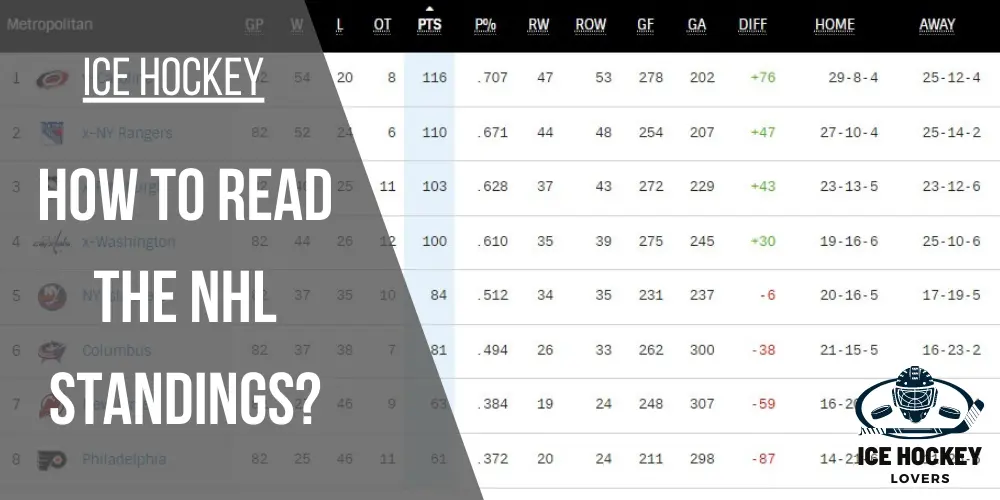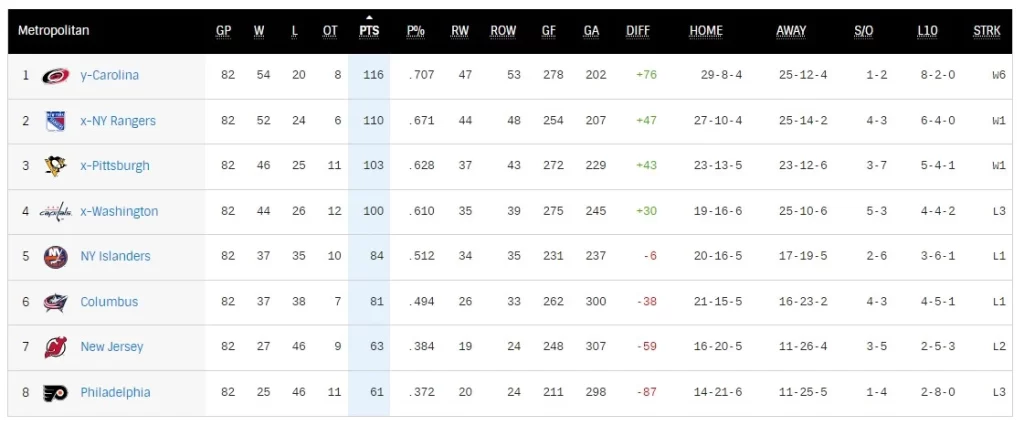The Ultimate Guide to How to Read the NHL Standings?

To all hockey fans and sports enthusiasts, you must know about point standings. And who wouldn’t know? We all want to know where our favorite teams stand and their current performance. Therefore, all the games have their respective point standings to keep up with team information.
The NHL standings are intended to show a team’s position at any time to know whether they will make it into the Stanley cup playoffs. And the main thing that management looks for the teams is ‘Points’ abbreviated as ‘PTS’ or ‘P’, how many points each team has to go into the Stanley cup playoffs. Each team battles for enough points till the end of the season to qualify for playoffs.
National Hockey League keeps the record and maintains the point standings for hockey. Together let us know more about how NHL standings work. If you don’t know about the NHL point standings, these are point tables that show a team’s performance at a particular instant and if a team can go far in the Stanley Cup playoffs. They determine a team’s points and its position among other teams.
Table of Contents
How to Read the NHL Standings?
The tricky part is reading the NHL standings. In the beginning, the standings might confuse you with the symbols and abbreviations, but it is easier once you understand how they work.
Besides, everything is difficult in the beginning and becomes easier with time, no? Anyways, back to reading the NHL standings. Let us start with the basics. The NHL standings contain 16 columns.

Above is a screenshot of the points displayed in the NHL standings on the NHL’s official website. Below we discuss what all these abbreviations mean.
| Abbreviations | Meaning |
| X | Clinched Playoff Spot |
| GP | Games Played |
| W | Wins (worth two points) |
| L | Losses (worth zero points) |
| OT | OT/Shootout Losses (worth one point) |
| PTS | Points |
| P% | Points Percentage |
| RW | Regulation Wins |
| ROW | Regulation Plus Overtime Wins |
| GF | Goals For |
| GA | Goals Against |
| DIFF | Goal Differential |
| HOME | Home Record |
| AWAY | Away Record |
| S/O | Record in Games Decided by Shootout |
| L10 | Record in Last Ten Games |
| STRK | Streak |
So, this is how the NHL displays a team’s complete record in its standings, and points are determined.
Below is a table of 2021 – 2022 records in the NHL standings.

Can you now read the table above to determine a team’s, for example, New Jersey performance during the regular season of 2021 – 2022?
NHL Playoff Standings
All the regular seasons of the NHL are about making it to the Stanley Cup playoffs. That is the primary aim of every game played; to gain enough points to reach the playoffs.
The teams that are the top scorers in a conference qualify for the playoffs. So, score as much as you can. A league has a total of 31 teams, out of which 16 teams qualified, meaning eight teams from each conference.
To find out if your team will qualify for the playoffs, you need to be able to read the standings, and you must know how they work.
The symbols discussed above are two things to understand in the NHL standings. Secondly, you need to know how the teams are grouped into conferences, divisions, and wild cards in the standings. This is because this helps determine a team’s position and find out if the team is in a position to qualify for playoffs.
What is with All of the Names and Symbols in the Standings?
We have discussed all the symbols used in the standings in the table above. Here is a short description of the signs that may seem difficult to understand.
- OT – which is for the overtime or shootout losses equals 1 point for the team.
- PTS – is the total number of points from wins, losses, and overtime or shootout losses.
- ROW – is the Regulation plus overtime wins. It depicts the total number of games won in the regulation play or the overtime. This gives lesser weightage to the shootout wins. If two teams have equal points in the standings, ROW determines which team will stand first.
- GF – goals for, is the number of goals a team has scored in that season. If a team wins in the shootout, it will get one point in the GF.
- GA – stands for goals against and depicts the number of goals a team has allowed that season.
- DIFF – stands for Goal Differential. DIFF shows the total number of goals a team has scored subtracted by the total number of goals against them.
- HOME – shows the home record. All the teams play 41 games each season, known as the record at home. The record is placed in the table as Wins – Losses – OT. This record is not much vital overall.
- AWAY – shows the team’s record performance in the games not played at home. Teams usually play another 41 games away from their home rink. It also has no significance in deciding the team’s position in the standings.
How to Calculate the Points for a Team’s Record?
To calculate the points of any team, check out their wins, losses, and overtime or shootout losses. Wins equal two points; losses are zero points, while overtime/shootout losses are one point. Calculate the points and add them.
For example, for a record of 25 – 18 – 10;
- 25 wins will equal 50 points
- 18 losses mean 0 points
- And 10 overtime/shootout losses will equal 10 points.
- Hence, the total points of this team will be 60 points.
This is how the NHL calculates a team’s points in a season.
Who is in the Playoffs, and Who is Not?
We have learned to read the NHL standings, identify the symbols, and discuss the calculation method of a team’s points from its record.
The next thing to understand is the stats sheets.
Out of the 31 teams, only the top 16 teams qualify for the Stanley Cup playoffs. Every conference has eight playoff spots, out of which the first six will be comprised of the top 3 scorer teams from every division. The last two spots are reserved for wild cards, the top-scoring teams in the conference beyond the top three of every division.
So, how do you read NHL stats? There are four basics to understand:
- League
- Conference
- Division
- Wild Card
League – Leagues are the NHL teams arranged in descending order concerning their points; the teams with the highest points will stand first, while those with lower points will be at the bottom.
Conferences – The division of teams into their respective conferences, the Eastern and the Western. All 31 teams are divided into these two conferences. A team has to defeat the other teams in its conference to qualify for the Stanley Cup finals. Each of the two conferences is divided into two further divisions.
Divisions – Depict the divisions of the NHL teams into their four respective divisions: Metropolitan, Atlantic, Central, and Pacific. The first three teams in each division qualify for the Stanley Cup playoffs. Therefore, the division standings are essential.
Wild Card – Combines the Division and Conference standings showing the top three teams in each of the two divisions within the conference. The first two-point teams qualify for the playoffs and play the two division winners in the wild card race.
So, the NHL conference standing and the NHL division standings are different, and the NHL conference standings are more important. And this is how we read the NHL standings.
As said earlier, it might confuse you initially, but as you ponder it, you will find out that it is not much difficult to understand. Please read the article, check the standings and apply the rules; that is it.
A final message as food for the soul from hockey; just like the points and performance of the hockey players and teams are being recorded, our actions are also being recorded somewhere. Our performance in everyday life determines our positions in people’s minds and hence their behavior toward us. This has a significant impact on everything.
Conclusion
In conclusion, now you can read and understand how NHL standing works. But keep in mind when looking for your team standings that they are flexible and will change. The team’s standings change a lot in a couple of weeks, and they can go on a winning streak and come to the verge of losing. So, please stay on the NHL season’s standings roller coaster ride and enjoy it.
So, watch your performance every day.

Who is Austin Taylor?
Meet Austin Taylor, your go-to source for everything ice hockey! With a passion for the sport that’s as deep as the ice itself, Austin Taylor brings you concise, expert insights and nitty-gritty details on all things hockey. From gear reviews to strategy breakdowns, Austin Taylor is your trusted guide to navigating the exhilarating world of ice hockey. Get ready to lace up your skates and dive into the game with Austin Taylor as your ultimate companion.




